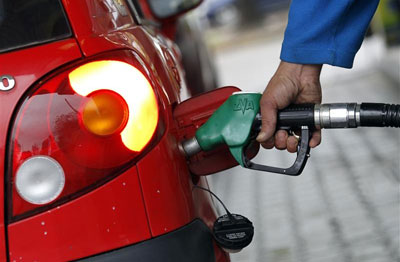
US gasoline demand 'to hit record high this summer'
LONDON, March 21, 2016
The United States will probably consume a record amount of gasoline in 2016, passing the previous peak set in 2007, and the prospect is helping lift crude oil prices, according to an expert.
Recent data indicates the country is on track for its biggest-ever driving season this summer, which will keep refineries running flat-out turning crude into the motor fuel, remarked leading Reuters market analyst John Kemp.
A rapid expansion in US gasoline consumption has coupled with strong demand growth in India and China, falling crude output in the US, and hedge funds turning bullish, to send crude and fuel prices surging.
US motorists consumed 9.16 million barrels per day (bpd) of gasoline in 2015, just 125,000 bpd short of the record 9.29 million bpd set in 2007, he stated citing data.
The US Energy Information Administration (EIA) is still forecasting consumption in 2016 will remain slightly below the 2007 peak.
On February 23, the EIA published a commentary titled "Motor gasoline expected to remain below 2007 peak despite increase in travel".
But the agency has been revising its estimates higher in response to the extraordinary strength in demand exhibited in recent high-frequency data.
In December 2015, the EIA predicted gasoline consumption would rise by just 10,000 bpd in 2016. By January, it had upped its forecast increase to 70,000 bpd and in March, the agency raised the number to 90,000 bpd.
The upward revisions come amid statistics showing gasoline demand already running at record levels.
In the four weeks to March 11, implied consumption of gasoline averaged almost 9.4 million bpd, an increase of about 560,000 bpd compared with the same point in 2015.
Implied consumption, what the EIA calls "product supplied", was more than 200,000 bpd higher than the previous record for the time of year, set in 2007, and 400,000 bpd above the 10-year average.
The consumption numbers reported in the EIA's "Weekly Petroleum Status Report" are estimates and subject to a range of sampling and non-sampling errors.
The weekly estimates may be revised when data from more comprehensive monthly surveys becomes available.
But the weekly estimates tend to track the monthly estimates, especially when averaged over a four-week period to remove some of the short-term noisiness in the series.
Short-term consumption estimates can also be affected by regular seasonal factors as well as one-off events such as snow storms, floods and hurricanes.
Gasoline consumption estimates appear to have been affected by the severe Midwest floods and the East Coast snow storm in January.
Some analysts have suggested the current strength of implied consumption is partly a statistical effect as refiners and blenders push out winter-grade gasoline into the market before summer specifications kick in.
But the shift from winter-grade to summer-grade gasoline occurs at the same time every year so it is not clear how it could account for unusual implied consumption in 2016.
Despite some volatility, the weekly estimates have told a consistent story of strong year-on-year growth in gasoline consumption in recent weeks.
US refineries have been running hard to turn crude into gasoline to meet demand from motorists. In almost every week so far in 2016, refineries have processed a record amount of crude oil for the time of year.
In the week to March 11, US refineries processed nearly 16 million bpd of crude, up 15.4 million bpd in 2015, which was itself the previous record.
US refineries ran at 89 per cent of their rated operable capacity in the week to March 11, up from 88 per cent at the same point in 2015, 86 per cent in 2014 and 81 per cent in 2013.
Even with the refineries processing record amounts of crude for the time of year, gasoline stockpiles remain close to normal.
US stocks are equivalent to 26.6 days of consumption, almost identical to the 26.7 days at the same time in 2015, and only a little over the long-term average of 25.5 days.
With demand ahead of last year, refineries running at seasonal records, stockpiles near normal, and the summer driving season on the horizon, refinery processing seems set to ramp up substantially.
The prospect of record demand from US motorists for gasoline, and record demand from US refineries for crude, has helped drive both spot prices and spreads higher.
Futures prices for gasoline delivered in June 2016 have surged 29 per cent, from $1.15 per gallon at the start of February to nearly $1.50 currently.
US crude futures with the same maturity have risen by 23 per cent over the same period and are up 37 per cent from their low in mid-January.
The rise in spot gasoline and crude prices has coincided with a predictable strengthening of the price spreads for crude and refined fuels in the second half of the year.
Hedge funds have amassed an enormous bullish bet on a further increase in crude prices, in large part because of the strength of fuel demand from markets such as the US and India.
Hedge funds and other money managers had amassed a net long position equivalent to in the three big crude oil contracts on the New York Mercantile Exchange and ICE Futures Europe.
The net long has more than doubled from its recent low of just 231 million barrels on December 22, and is closing in on the May 2015 high of 572 million and the June 2014 record of 621 million.
Previous attempts by the hedge funds to establish large net long positions in anticipation of a rebound in oil prices in March/April and August/October 2015 fizzled out, with prices dropping to fresh lows.
But for the third time since the start of 2015, hedge funds are gambling on higher prices on the horizon, in part thanks to the thirst for gasoline from US motorists.-Reuters







